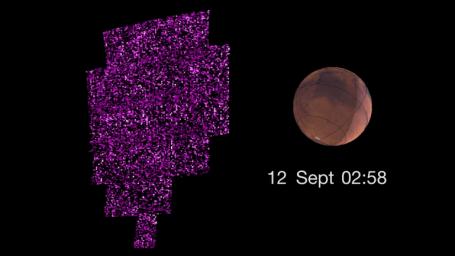Solar Storm Triggers Whole-Planet Aurora at Mars (Video)
Caption:
View the animation
This animation shows the sudden appearance of a bright aurora on Mars during a solar storm. The purple-white color scheme shows the intensity of ultraviolet light seen on Mars' night side over the course of the event.
The data are from observations on Sept. 12 and 13, 2017, by the Imaging Ultraviolet Spectrograph instrument (IUVS) on NASA's Mars Atmosphere and Volatile Evolution orbiter, or MAVEN.
The aurora is occurring because energetic particles from the solar storm are bombarding gases in the planet's atmosphere, causing them to glow. A simulated image of the Mars surface for the same time and orientation is also shown, with the dayside crescent visible on the right. The auroral emission appears brightest at the edges of the planet where the line of sight passes along the length of the glowing atmosphere layer.
Note that, unlike auroras on Earth, the Martian aurora is not concentrated at the planet's polar regions. This is because Mars has no strong magnetic field like Earth's to concentrate the aurora near the poles.
Background Info:
NASA's Goddard Space Flight Center in Greenbelt, Maryland, manages the MAVEN project for NASA's Science Mission Directorate, Washington. MAVEN's principal investigator is based at the University of Colorado Boulder's Laboratory for Atmospheric and Space Physics, where the mission's IUVS team is also based. Lockheed Martin Space Systems, Denver, built and operates the spacecraft.
For more information about MAVEN, visit
http://www.nasa.gov/maven
and
http://lasp.colorado.edu/home/maven/
.
Cataloging Keywords:
| Name |
Value |
Additional Values |
| Target |
Mars |
|
| System |
|
|
| Target Type |
Planet |
|
| Mission |
Mars Atmosphere and Volatile Evolution (MAVEN) |
|
| Instrument Host |
MAVEN |
|
| Host Type |
Orbiter |
|
| Instrument |
|
|
| Detector |
|
|
| Extra Keywords |
Atmosphere, Color, Magnetosphere, Storm, Ultraviolet |
| Acquisition Date |
|
| Release Date |
2017-09-29 |
| Date in Caption |
|
|
| Image Credit |
NASA/GSFC/Univ. of Colorado |
| Source |
photojournal.jpl.nasa.gov/catalog/PIA21854 |
| Identifier |
PIA21854 |

 Planetary Data System
Planetary Data System
